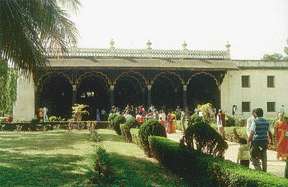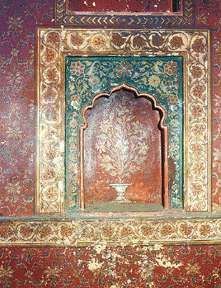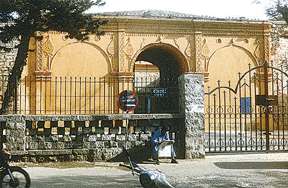|
Tipu's
Palace in Bangalore - Fading fortress

SURESH MOONA suggests a new dimension to tourism
in Bangalore city.
BANGALORE is changing. Sobriquets like IT capital, Silicon
City, Seminar City, are replacing the old ones. In spite
of the hype surrounding Hyderabad, Bangalore attracts people
from all over the world.
International conferences and the recent global investors'
meet bring bureaucrats, business tycoons, diplomats and
tourists.
After checking into five-star hotels, these people do like
to have a glimpse of the city.
Many of them seek information from tourist guides published
abroad, some of these books, while writing about Bangalore,
have made disgraceful remarks such as, ''there is nothing
to see in Bangalore ... there is hardly anything to see
in Bangalore".
Though, such remarks in interna-tional guides do hurt the
sentiments of true Bangaloreans and monument lovers, it
is a fact that many heritage structures and sites are neither
exposed properly nor made tourist friendly. Such drawbacks
would prompt any author of tourist guides to make such remarks.
The city has an inflow of tourists including world luminaries.
Tour operators and authorities have to give a new dimension
to tourism in Bangalore city.
The City market area is a very important heritage site
of the city, the extended Stone Fort of Haider's period,
Tipu's palace, and the Armoury are prominent pages of Bangalores
History.
A fort was built around Bangalore for the first time by
its founder, Kempegowda. After the rule of the Gowdas, an
extension was made to it by Chikkadevaraya, who added an
oval fort to the existing one. Later it was strengthened
by Haider Ali.
Ibrahim Khan, the kiledar of Bangalore built the fort in
1761 and it was considered a formidable structure in 1791,
in the best fashion of Muslim military architecture.
But after the 1791 war, parts of it were dismantled, since
it was not strong enough to withstand the attack of the
British. Later Dewan Purnaiah rebuilt it in 1800.
An
old painting at the palace

The main Mysore gate which was to the south is still intact
near the city market .
There was another main gate called the Delhi Gate towards
the northern side of the fort. It was said to be a magnificient
structure.
One can now get into the fort through the southern gate
from K R Road, or from the Vani Vilas Hospital side. This
gate is not only strong but very attractive, with beautiful
floral designs at the top of the entrance. The walls on
either sides of the entrance are black. May be the paint
or writing on the walls has eroded over the years.
A similar type of blank space can be seen at the gate (northern
gate which is now closed), near the Dental College. There
is clear evidence of tampering. The walls and roof of the
inner portion of the entrance near the Dental College are
tarnished by graffiti.
The doors of the southern gate are strong, tall and thick.
A little beyond the entrance is the Ganesha Temple. There
are other archaic structures beside a spot which was used
to confine prisoners of war. There are some interesting
reliefs on the walls of the fort and the lawn inside the
fort is well-maintained.
The most important, and interesting aspect of this fort
is a white memorial tablet found on the outer wall opposite
the Kote Anjaneya Temple. The message on the tablet reads,
''Through this breach the British assault was delivered.
Dated March 21, 1791".
This writing takes us back to an event in 1791, which not
only gave a twist to the history of Bangalore, but also
altered the future of Tipu Sultan. During the third Mysore
war, Lord Cornwallis led the army to the outskirts of Bangalore.
Tipu was surprised by this move, as he was expecting him
at Srirangapatna.
He rushed to Bangalore and camped at Kengeri, entrusting
the task of facing the British forces to his trusted officers,
Syed Sahib, Kamruddin Khan and a few others.
All arrangements had been made to face the British. Syed
Sahib was in charge of Peta region and Kamruddin Khan was
to face the enemy at the Western side of the fort. While
all these arraragements were being made, some of the local
leaders who were disgruntled with Tipu hatched a conspiracy
against him.
They knew in advance about the British attack and approached
Cornwallis. They assured him of help in capturing the fort
provided he guaranteed them protection. Cornwallis willingly
agreed.
Syed Sahib had made tight security arrangements at Halsoor
gate to prevent the entry of the enemy. On the western side
fighting had already commenced between Kamruddin Khan and
the British. At the same time, about 1,000 soldiers, with
Cornwallis, came in disguise to the eastern side. They found
a breach in the wall of the fort and forced their entry
through it. While Syed Sahib was fighting the enemy he was
attacked from behind by these soldiers. He was shocked to
see them come from inside the fort. He fled the battlefield
immediately to save himself. Seeing their leader withdraw,
the army
was in disarray. Thus Cornwallis could easily capture the
fort.
Fort
at City Market

Bangalore remained under the British for one year after
the seizure. It was handed back to Tipu Sultan under the
terms of the Treaty of Srirangapatnam, which was signed
on March 19, 1792. In spite of such a thrilling history
behind it and attempts made by the authorities to make it
attractive, few visitors frequent this structure. There
is absolutely no space at all for even a car or a taxi to
park anywhere near the fort. If tourists are determined
to visit, they have to venture through unclean roads. As
the edifice is surrounded by a hospital there is no scope
to improve the present condition. Thus an
important memorial, in the heart of the city, is doomed
to remain just a mute witness to mundane happenings around.
Tipu Sultan's Palace, to the west of Venkataramana Swamy
Temple near Bangalore Medical College, is another compelling
one among the old structures remaining in Bangalore.
The palace, temple and the armouries will be described
in the next of the series.
(The author is the director of AARAMBH)
Photos by the author
|

